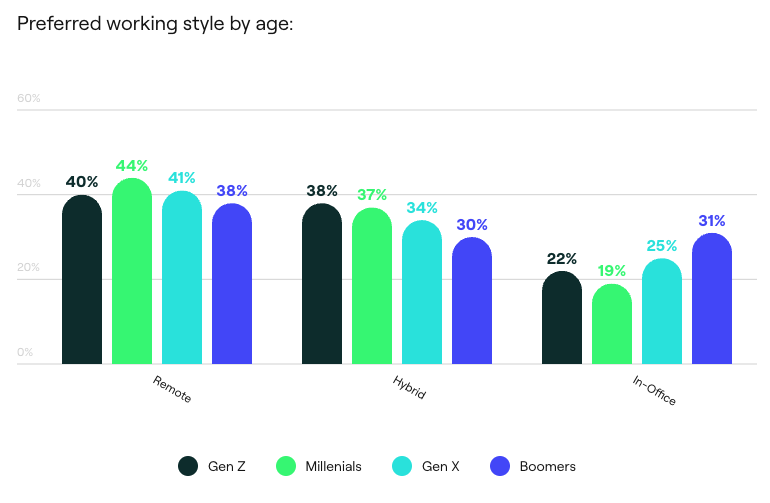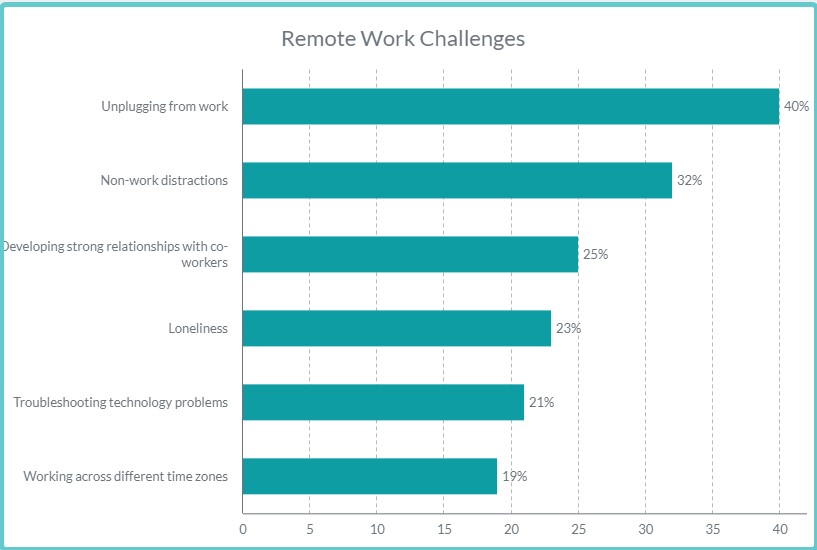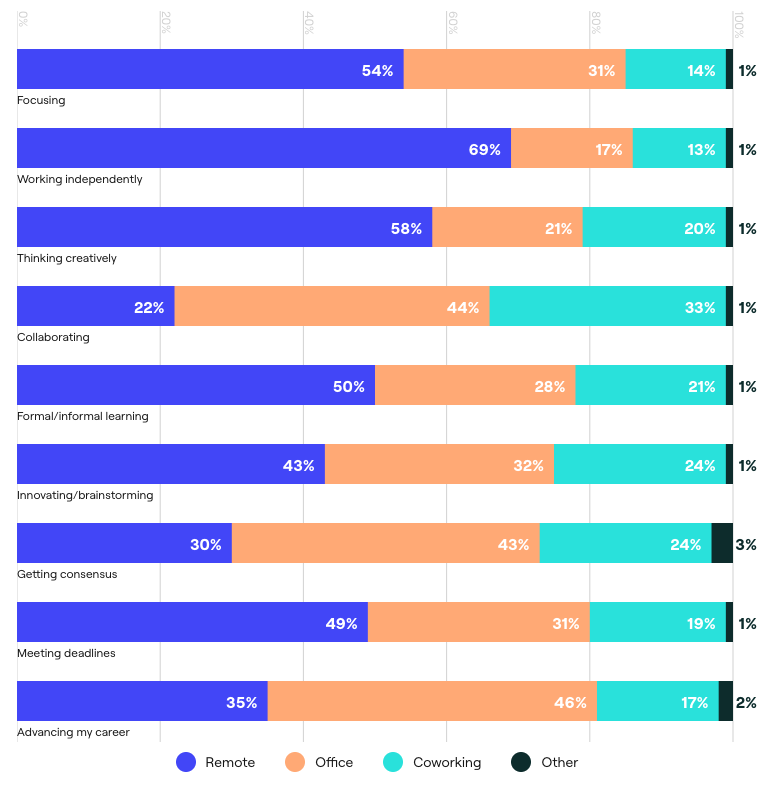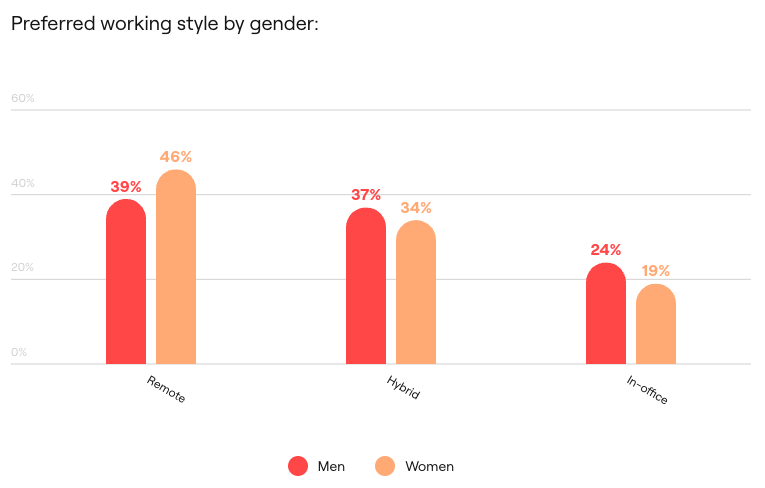
Remote Work Statistics: 50+ Key Facts to Know in 2025
Saving time and effort with Notta, starting from today!
The year 2023 marks the fourth year of remote work becoming the alternative to traditional office work since the pandemic transformed how we work. Now, millions of professionals across the world work from home, often in global teams that may need to transcribe in Spanish or other languages. This remote work boom has even been dubbed, “the greatest change to the labor market since World War II”.
Work-from-home statistics show that remote work has rapidly increased in popularity with remote job options growing by more than 1100% since mid-2021. Reports also suggest that teleworkers are more productive than their in-office counterparts, thanks to fewer distractions, more flexible schedules, and the adoption of tools for AI transcription.
But there is still a lot to understand about how remote work is shaping the future of work, its cost, and its impact on employees and businesses. In this article, we’ve curated the ultimate list of remote work statistics and facts that will give you a better understanding of the state of remote work.
Key statistics on remote work
The following are important discoveries from surveys by Owl Labs, Global Workplace Analytics, and other renowned business research authorities:
The percentage of work performed at home rose from 4.7% in January 2019 to 61% in May 2020.
The remote workplace services market is expected to grow from $20.1 billion in 2022 to $58.5 billion by 2027 at a CAGR of 23.8%.
Globally, 16% of companies are fully remote while 44% of companies don't allow remote work of any kind.
A whopping 83% of the global workforce considers hybrid work ideal.
Since 2021, the number of workers choosing to work remotely increased by 24% and those choosing hybrid work went up by 16%.
59% of workers would likely choose an employer who offered remote work options to those who didn’t.
Remote workers save an average of 72 minutes daily from commuting, that is 6 hours a week.
The average U.S. employer can save $11,315 annually on each part-time remote employee.
1 in 2 professionals (52%) would take a pay cut of 5% or more to have flexibility in working location, while 23% would take a pay cut of over 10%.
55% of remote workers work more hours from home than they do in the office.
Only 20-25% of companies afford their employee’s cost for home office equipment and furnishings.
Remote work can reduce 54 million tons of carbon emissions into the atmosphere each year.
What are the benefits of remote work?
Remote work has specific benefits for employees, employers, and the general public. Several studies have shown that remote work delivers desirable outcomes for each of these groups and we will elaborate on them as follows.
For employees
Save commuting time
A study by the National Bureau of Economic Research revealed that remote workers saved an average of 72 minutes that would otherwise be spent on their daily commute to and from their on-site jobs in 2021 and 2022.
40% of the time saved was redirected to primary and secondary jobs, 34% to leisure (like using tools to summarize YouTube video tutorials for personal development), and 11% to caregiving activities.
Another study estimates that employees who work remotely for half the time save the equivalent of 11.4 workdays every year and this could be more for extreme commuters - who could even spend three times more than that.
Money is saved
A report by Global Workplace Analytics estimates that employees save between $600 and $6,000 yearly by working at home half the time. The sum saved is primarily due to reduced costs for travel, parking, and food.
Increased happiness
According to Tracking Happiness which conducted a survey of 12,455 respondents, fully remote increases employees' happiness by 20%. This survey showed that the average work happiness of people who worked on-site 100% of their time is 5.90 on a scale of 1-10, compared to 7.04 for remote workers.
It was further discovered that the average employee’s happiness increases by 3% for every added remote workday. And the Millennials are happiest when telecommuting.

Better work-life balance
In Flex Job’s survey, which analyzed 800+ US employees, 48% of correspondents with flexible work options (part-time work, freelance, remote work, etc.) said their work-life balance is excellent or very good, compared to 36% of respondents without flexible work.
This means the ability to work flexibly increases employees’ chances of having a healthy work-life balance by about 30%.
Improve mental health
According to a report by Mental Health America, 77% of professionals believe that having flexible work options would improve their mental and physical health.
Likewise, the Owl Labs State of Remote Work report in 2021 found that 82% of American employees say that working from home after the pandemic is better for their mental health.
For employers
Beyond the more obvious benefits such as cost reduction, remote work has also been proven to improve employee retention and performance.
Improve engagement and productivity
According to a Gallup study, employee engagement climbs when they have the flexibility to work remotely as well as in the office. Higher engagement also reduces absenteeism by 41% and quality defects by 40%.
The ideal engagement boost happens when employees spend between 60% and 80% of their time working off-site, i.e, three to four days in a five-day workweek.
It has also been reported that businesses lose about $600 billion per year to workplace distractions, an additional cost that could be avoided by adopting remote work and guaranteeing employees’ productivity at home.
Save corporate cost
Companies save an average of $11,315 every year on an employee who works remotely part-time, and can further reduce costs by utilizing free transcription software for meetings, leading to 21% higher profitability..
In another report by Global Workplace Analytics, it was revealed that IBM saved around $50 million in real estate costs by simply hiring remote workers.
A survey by Owl Labs also discovered that part-time on-site employees spent an average of $863 per month on work-related expenses while remote employees averaged less than half that amount, spending $423 per month on the internet, phone, meals, utilities, and other expenses. That is a difference of $440 per month or $5,280 for a year.
Attract and retain talent
54% of professionals expressed that they would change jobs for one that offers more flexibility. This came to an about 12% reduction in turnover when remote work was presented as an option.
Moreover, as we mentioned above, employees are willing to take pay cuts to work remotely.
For the general public
The increased adoption of remote work, not only reduces traffic, accidents, and other transport inconveniences for road users but also positively impacts the environment by reducing pollution and greenhouse gas emissions.
In 2020 when travel restrictions were issued and remote work peaked, emissions from transportation fell by 15%. And while most of the world has opened up again, remote work is expected to continue to impact the environment positively.
Global Workplace Analytics also estimated that remote work can reduce emissions by 54 million tons. The impact of this is the equivalent of taking almost 10 million cars off the road for a year!
Other benefits of remote work to the general public according to the Telework Savings Calculator include:
Reducing wear and tear on highways by over 119 billion miles a year, saving communities hundreds of millions in highway maintenance.
Saving almost 90,000 people from traffic-related injury or death, thus reducing accident-related costs by over $10 billion a year.
Saving over 640 million barrels of oil valued at over $64 billion
Notta offers the most integrated AI meeting notes, summaries, and action items so nothing gets missed.
Are there any cons of remote work?
While remote work has an impressive list of benefits, it also has notable disadvantages.
1. 22% of professionals feel isolated from others when working remotely
A study conducted by MIT revealed that workers felt significantly more lonely when working from home than in the office. 22% of the workers surveyed said that they felt isolated from others when working from home, compared with 19% who felt the same way when working in the office.
2. 40% of remote workers have a hard time unplugging from work
According to a Remote co survey of 200 full-time remote workers, 40% of respondents believe unplugging after work hours is the biggest challenge remote workers face. tools to quickly transcribe voice memos can help capture fleeting ideas without getting pulled back into a full work session.
In effect, over 1 in 3 remote workers are not getting enough rest and time off work.
Other challenges include:
Non-work distractions - 32%
Developing strong relationships with co-workers - 25%
Loneliness - 23%
Troubleshooting technology problems (like needing to convert m4a to text from a mobile recording) - 21%
Working across different time zones - 19%

3. More than 2 in 3 remote workers are experiencing burnout
69% of remote employees are burnt out. Despite this, 59% of remote workers are still failing to take enough time off and 42% are not planning to take any time off.
Remote and hybrid workers tend to experience higher rates of mental health issues than on-site workers.
A study by the University of Maryland showed that 40% of fully remote workers and 38% of hybrid workers experience an increased likelihood of anxiety and depression symptoms, compared to the 35% of in-person workers,
Statistics on remote work productivity
The numbers above show that remote work is on the rise and has numerous benefits, but are remote workers more productive?
In this section, we'll explore statistics on remote work productivity, which can be boosted by tools that create an mp4 to transcript from video meetings or convert mp3 to text from audio recordings. Some statistics might sometimes appear contradictory; however, there is a lot of evidence that supports the notion that remote workers are more productive on average.
4. Two in three workers feel more productive when working remotely
According to Owl Lab’s 2022 State of Remote Work Report, 62% (around two-thirds) of workers feel more productive when working remotely, while only 11% feel less productive (they say this is because there are more distractions).
The results were seen to vary depending on the employee’s age. Millennials feel most productive while working from home (66%), while Boomers feel the least productive(46%).
However, it should be noted that 53% of remote employees reported that they were working more hours than when they were in the office.
5. Remote workers are 35-40% more productive than their office counterparts
According to companies like Best Buy, British Telecom, Dow Chemical, and others, teleworkers are an average of 35-40% more productive than employees who work in the office. And over 65% of employees reported increased productivity.
Another study by Standford, which observed the performance of call center workers for nine months, found that the employees who worked from home were 13% more efficient because they were working 9% minutes more per shift and handling 4% more calls per minute.
6. 67% of hybrid workers feel more productive when working from home
Most hybrid workers, who experience both remote and on-site work, feel more productive when working from home than when they are working in the office.
Here’s where hybrid workers say are the most productive:

7. Hybrid and remote employees have a higher engagement rate
According to the Quantum Workplace report published in August 2021, in the past 18 months, hybrid workers have had the highest employee engagement rate (81%). Fully remote workers, on the other hand, have a 78% engagement rate while on-site employees have the least high engagement levels with 72%.
8. 1/3 of hiring managers say that productivity has increased as a result of remote work
According to Upwork’s The Future of Work Report, 32.2% of hiring managers found that employee productivity has increased since they adopted remote work while 22.5% said that it has decreased.
9. Remote employees are experiencing burnout
Despite increased productivity, according to a report by Indeed, 38% of employees suffer remote work burnout because they feel pressured by their company’s management to work longer hours while 21% say that it is a combination of pressure from managers and customers or clients.
It is also noteworthy that 48% of employees working from home say they lack emotional support, which could also contribute to experiencing burnout.
10. 44% of employees find collaborating with colleagues in the office more productive
The majority of professionals (44%) find collaborating in the office more productive than the 22% who find collaborating remotely more productive. 33% found collaborating in co-working spaces more effective while 1% represented other work options.
Why remote workers are more productive
Different studies have been conducted to understand why remote workers are, on average, more productive than their on-site counterparts. The consensus of most of these studies suggests that remote workers are more productive for the following reasons:
Working longer hours: According to a report by Nature Human Behavior which examined the habits of over 60,000 Microsoft employees, remote workers spent 10% longer logged in each week. This translates to an additional four or more hours of additional work.
It is important to note that working longer hours might backfire if employees do not take time out to rest adequately.
Higher job satisfaction: According to a report by Tech. co, remote employees experience a higher level of job satisfaction than on-site workers. The value of this to productivity becomes apparent when we consider a study by the Harvard Business Review which revealed that employees who are satisfied with their jobs are 31% more productive, and using tools like an ai note taking app can reduce workload and further boost satisfaction.
In more recent research by Oxford University’s Said Business School, it was discovered that employees are 13% more productive when they are happy.
Lower absenteeism: Research by the Centre for Disability Awareness discovered that remote-work occupations have lower employee absence rates on average. The effect of this is that remote workers are invariably spending more days working than on-site workers.
Employees’ attitudes toward remote work
The consensus of reports shows that the majority of employees prefer remote work - either full-time or as a hybrid option.
During the pandemic, 66% of professionals said that they would prefer to work remotely full-time after the pandemic is over, while 33% would like to have a combination of in-office and remote work.
11. The number of workers choosing to work remotely increased by 24% from 2021 to 2022
In a similar vein, based on the Owl Labs report, the number of workers who chose hybrid work, went up 16% within the same period, while employees choosing to work from the office dropped by 24%.
The same report finds that more than half (52%) of employees are willing to take a 5% pay cut to work remotely while 23% are willing to take a 10% pay cut or more.
12. 46% of women prefer full-time remote work, compared to 39% of men
Gender may be a factor in the preference for telework. The same report shows that overall 80% of women prefer the remote and hybrid work style, compared to 76% of men. For on-site work, 24% of men voted in favor, compared to 19% of women.

13. 39% of employees are likely to change jobs if their companies don’t allow remote work
According to a report by Bloomberg, 39% of employees are likely to change jobs if their bosses are not flexible about remote work.
74% of workers also said that they would quit their current job if another company offered them remote work.
14. 29% of employees are searching for new jobs that allow remote work
In a survey by FlexJobs, respondents were asked what employees would give up to work remotely, and the following findings were made:
44% of workers know at least one person who has quit or will quit their job due to in-person work requirements
29% are searching for new jobs that allow remote work
17% of the respondents would quit their job if it did not offer remote work options
21% would give up some vacation time to work remotely
15. 2 in 5 employers will adopt hybrid working by 2023
Hybrid work is expected to become more popular in 2023 and beyond. A poll by Willis Towers Watson which surveyed senior employee benefits professionals at 121 UK companies found that 41% of employers would adopt hybrid working in 2023 and only 30% of businesses can expect to have their workforce fully back on site before 2023.
16. Employees who work from home were found to be more optimistic about work
89% of employees who work from home are optimistic about work, compared to 77% of those who work in the office.
Remote employees also experience greater job satisfaction (90%) than those who commute to work (82%).
Though overall remote workers seem more productive and satisfied, they also have some concerts, as shown below.
17. 49% of employees feel that their managers consider employees who work from the office as more hardworking and trustworthy than remote workers.
It is estimated that 60% of managers are skeptical about the productivity of their remote employees. This might be responsible for why 37% of employers have added or increased their use of employee activity-tracking software.
46% of hybrid workers believe that working for the office is better for career advancement.
There seems to be a bias in favor of employees who work in the office because even though hybrid workers admitted to being more productive at home in a range of activities, the majority feel like working from the office will help them advance their careers.
This is compared to 35% of those who think remote work will advance them, 17% for co-working, and 2% for other working styles.
Do employees want to return to the office?
Qualtrics surveyed 1,050 professionals to understand their expectations for a post-pandemic workplace and what policies and practices they consider appropriate and found the following:
18. 60% of all U.S. workers are hesitant to go back to the office because of the long commute times and feeling that they are more productive working from home
19. 67% of remote or hybrid workers plan to return to the office, but only 13% will work in-person full-time
24% plan to be in the office 3-4 times a week
21% plan to be in the office 1-2 times a week
9% plan to be in the office less than once a week
20. 33% do not intend to go back to the office at all
In effect, the vast majority of remote and hybrid employees are only willing to return to the office if they are required to work in the office full-time.
Similarly, in another survey, 83% of full-time remote workers say that they cannot imagine returning to an on-site office. In the same survey, 16% said that the remote work lifestyle is somewhat important to them. Only 1% say it would not be a big deal to give it up.
Remote work FAQs
What percentage of employees are working remotely?
26% of U.S. employees work remotely as of 2022 and 16% of companies are fully remote.
Are remote workers/teams productive?
Most reports show that remote workers are, on average, more productive. However, there are also several compelling reports to the contrary.
Owl Lab’s findings that the productivity of remote teams depended primarily on the specific work activity that the employee is carrying out is a more balanced response.
Which industry has the most remote workers?
The information technology, management, and consulting industries have the most remote workers, fields where employees often need to record lectures or create a podcast transcript generator for training content and ongoing education.
Are people happier working remotely?
Yes. Remote work has been proven to increase employees’ happiness by 20%.
Is remote work the future of work?
While remote work has steadily declined considerably after peaking in 2020, the level of its current adoption is still a fivefold increase relative to 2019, which means that many organizations still favor it.
Given current trends, the future of work is more likely to be a hybrid of remote and on-site work.
Conclusion
In conclusion, work-from-home statistics show that remote work is not just a temporary trend, but rather a shift in the way we work that is likely to stick around for the long term.
Additionally, new technologies are emerging that make remote work even more accessible and efficient, such as AI Transcription services, tools to convert audio to text, virtual collaboration tools, and cloud-based systems, and many companies are adopting new strategies to support remote work.
As we move forward, it is important to continue exploring the benefits and challenges of remote work to ensure that it remains a viable and sustainable option for employees and employers.
Accenture. The Future of Work 2022
Bloomberg. Return to the Office Five Days a Week? How About Never Again
CNBC. Remote Work Burn Out is Growing as Coronavirus Pandemic Stretches on
Environmental Protection Agency. Carbon Pollution from Transportation
Flex Jobs. Remote Work Statistics & Trends
Flex Jobs, Mental Health America Those With Flexible Work Report Better Mental Health
Gallup. Is Working Remotely Effective
Global Work Analytics. Telecommuting Trend Data
Globe News Wire. New Research Reveals Remote Workers Report Lower Employee Sick-Time Rates
Mental Health America. The Mental Health Benefits of Remote and Flexible Work
National Bureau of Economic Research. Time Savings When Working From Home
Owl Labs. State of Remote Work 2021 and State of Remote Work 2022
Quantum Workplace. Remote Work Statistics: The State of Remote Work
Remote co Full-Time Remote Workers Struggle Most with Unplugging After Work Hours
Sloan Review. The Loneliness of the Hybrid Worker
Stanford Business. Does Working from Home Work? Evidence from a Chinese Experiment
Tech Economy. Telecommuting: 79% of Employees Believe More Flexible Schedule Increases Job Loyalty
The Hill. Nearly 30 percent of work remains remote as workers dig in
Tracking Happiness. Remote Work is Linked to Happiness: Study of 12,455 Respondents
Upwork. The Future of Work Report.
U.S. Energy Information Administration. U.S. energy-related CO2 emissions declined by 11% in 2020
Workplace Insight. Remote Workers Struggle to Switch Off From Work